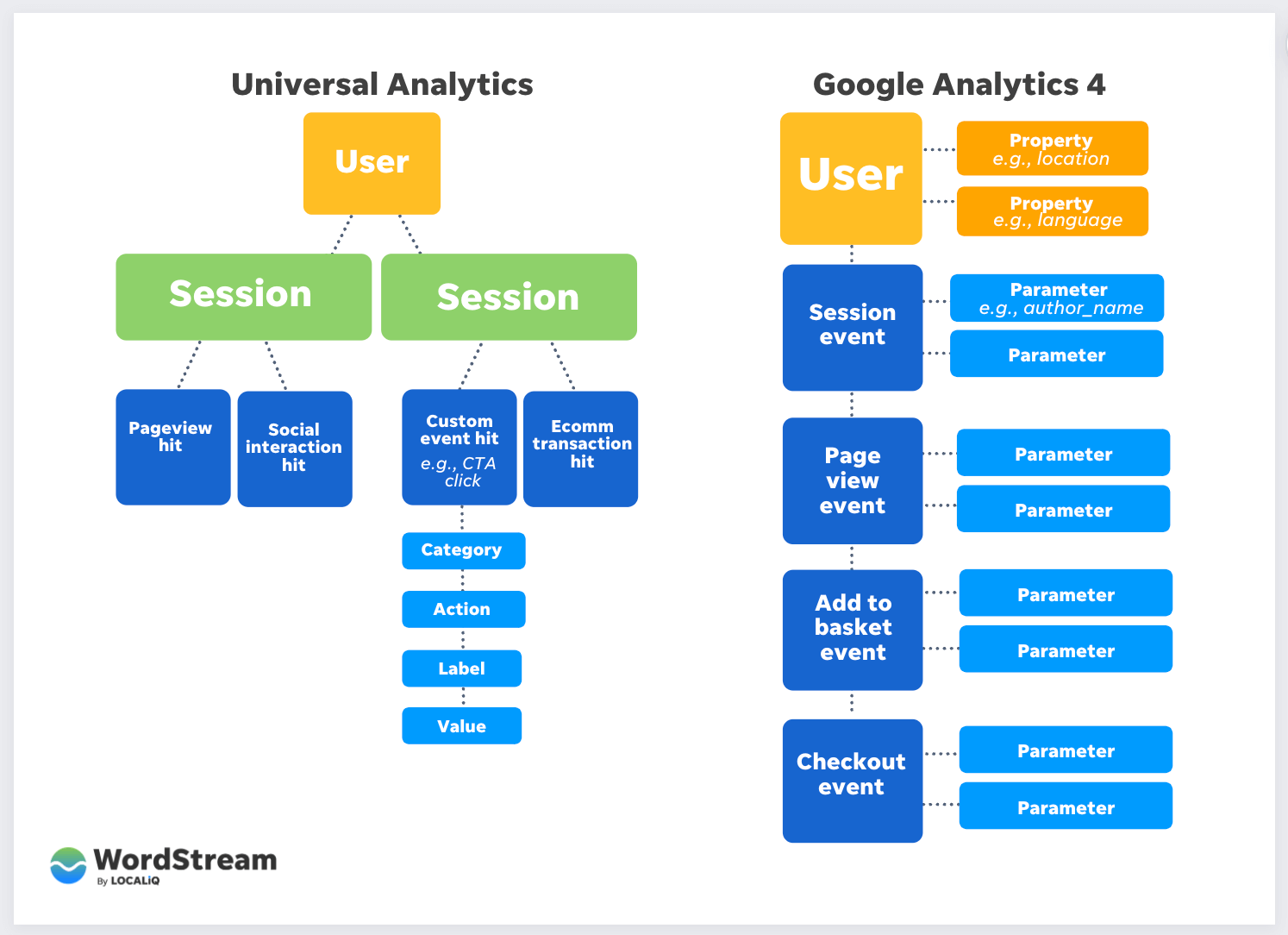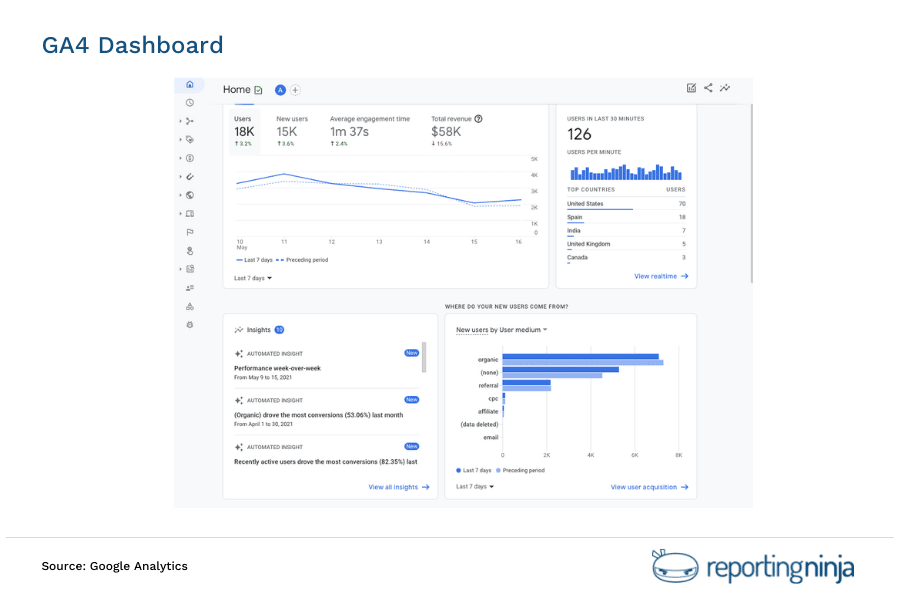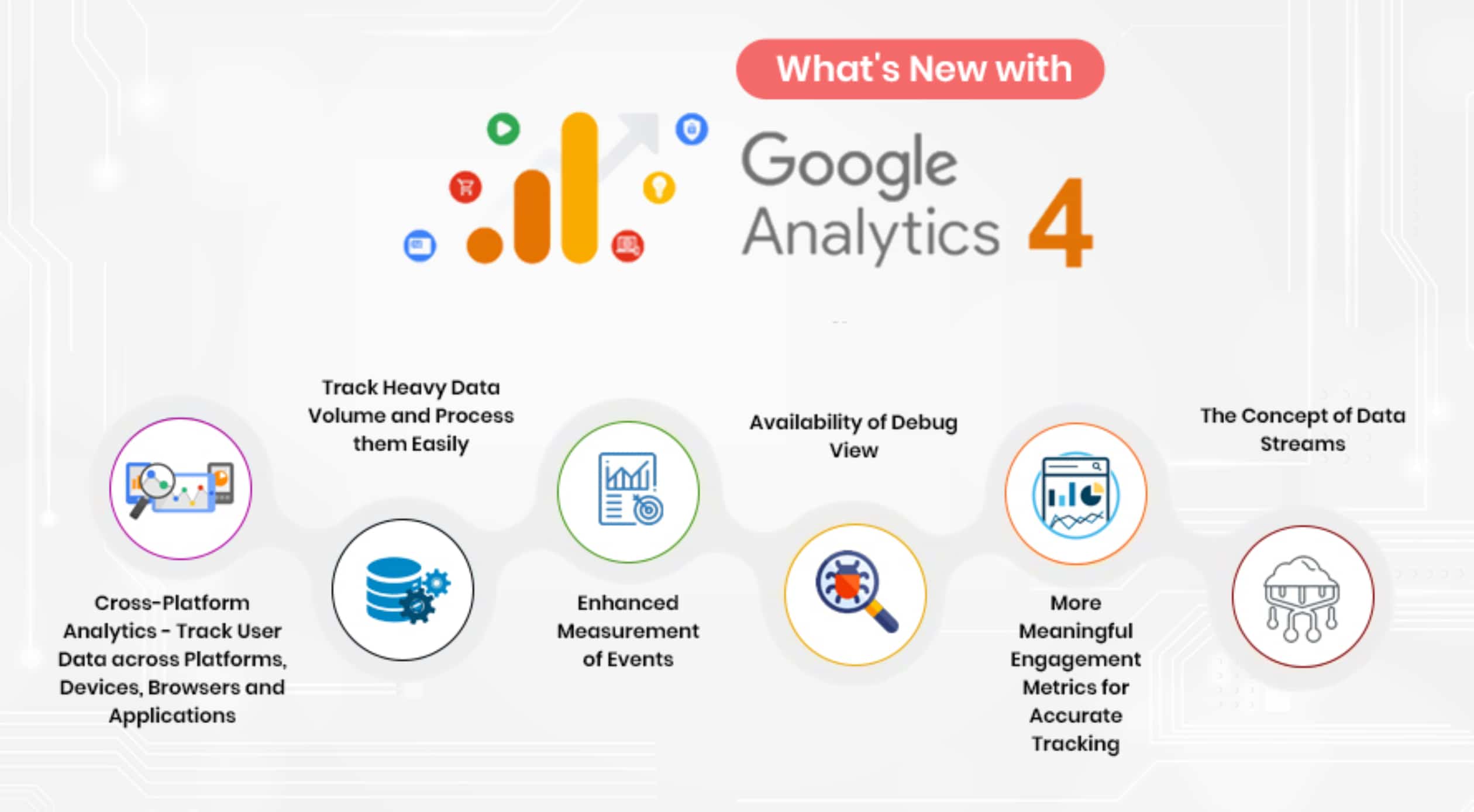GA4, the advanced analytics platform introduced by Google, has emerged as a game-changer for SaaS companies seeking to unlock the full potential of their data assets. With its event-driven data model, cross-device tracking capabilities, machine learning insights, and enhanced reporting interface, GA4 presents a compelling opportunity to revolutionize data-driven decision-making and drive growth.
We will explore the key differences between GA4 and Universal Analytics, provide insights on how SaaS companies can prepare for the required transition to GA4, discuss the importance of performing a data audit to ensure data accuracy and compliance, and highlight the process of evaluating how GA4 aligns with specific business needs.
By following the recommended steps and leveraging GA4’s advanced features, SaaS companies can harness the power of data, gain valuable insights, optimize user experiences, and stay ahead in the competitive SaaS landscape.
GA4 vs. Universal Analytics: Major differences to look out for
In the fast-paced world of SaaS companies, tracking and analyzing user behavior is essential for making informed business decisions. Google Analytics has been a go-to tool for web analytics, and with the advent of GA4 (Google Analytics 4), SaaS companies find themselves at the crossroads of transitioning from the well-established Universal Analytics.
Event-Driven Data Model: Unleashing Granular Insights
GA4 introduces an event-driven data model, revolutionizing the way SaaS companies capture and analyze user interactions. Unlike the traditional pageview-centric approach of Universal Analytics, GA4 enables granular tracking of specific events, empowering businesses to gain a deeper understanding of user engagement. By defining custom parameters and capturing events such as button clicks, form submissions, or video plays, SaaS companies can uncover valuable insights about user behavior and optimize their offerings accordingly.
Example: A SaaS company can track user interactions within their application, such as feature usage, onboarding progress, or subscription upgrades. This data provides actionable insights into user preferences, enabling targeted product improvements and personalized marketing strategies.
Enhanced Cross-Device Tracking: Unifying User Journeys
In the mobile-driven era, users often switch between devices while interacting with SaaS applications. GA4 addresses this challenge by offering improved cross-device tracking capabilities. By leveraging machine learning algorithms, GA4 allows businesses to stitch together user journeys across different devices, providing a holistic view of customer interactions. This unified data empowers SaaS companies to deliver seamless experiences and gain a comprehensive understanding of user engagement across platforms.
Example: A SaaS company can track a user’s initial interaction on a mobile device, continue monitoring their activities on a desktop, and analyze how these touchpoints influence conversion. This cross-device tracking helps identify the most effective user acquisition channels and optimize marketing efforts accordingly.
Machine Learning and Predictive Insights: Unleashing Data-Driven Decision-Making
GA4 incorporates machine learning to offer advanced insights and predictive analytics capabilities to SaaS companies. By harnessing the power of AI, GA4 can provide businesses with actionable predictions on user churn, lifetime value, and revenue opportunities. These predictive insights equip SaaS companies with the knowledge needed to proactively engage users, optimize retention strategies, and maximize revenue potential.
Example: Leveraging machine learning algorithms, a SaaS company can predict the likelihood of user churn based on various factors such as user behavior, usage patterns, and demographics. Armed with this knowledge, the company can implement targeted retention campaigns to reduce churn and improve customer satisfaction.
Streamlined Reporting Interface: Enhancing Data Visualization and Exploration
GA4 introduces a redesigned reporting interface, aimed at improving data visualization and exploration capabilities for SaaS companies. With user-centric reporting, GA4 offers a more intuitive and streamlined experience, enabling businesses to access key metrics, uncover hidden insights, and make data-driven decisions efficiently.
Example: The enhanced reporting interface of GA4 allows SaaS companies to create custom reports and visualizations, highlighting key performance indicators (KPIs) relevant to their business objectives. For instance, a SaaS company can create a custom dashboard to monitor key conversion funnels, user engagement metrics, and revenue attribution.
Preparing SaaS Companies for the Shift to GA4

Understand the Implications of GA4 Adoption:
Before embarking on the transition journey, it is crucial for SaaS companies to understand the implications of adopting GA4 fully. Analyze the key differences between GA4 and Universal Analytics, ensuring that stakeholders grasp the transformative potential of the new platform.
Example: According to recent industry reports, early adopters of GA4 have experienced a 31% increase in user engagement and a 23% uplift in conversion rates compared to those still using Universal Analytics.
Assess Existing Tracking Setup:
Perform a comprehensive analysis of your current tracking setup in Universal Analytics. Identify the tracking codes, events, and parameters that need to be migrated to GA4. Determine which custom dimensions and metrics are critical for your SaaS business and plan how to replicate or improve them in the new environment.
Example: Conducting an in-depth audit of your tracking setup might reveal opportunities to refine event tracking, enabling you to capture more specific user interactions that were previously overlooked.
Plan and Execute a Gradual Transition:
Transitioning to GA4 should be a phased process, minimizing disruption to ongoing operations. Start by setting up a parallel tracking implementation with GA4 while keeping Universal Analytics intact. This allows for side-by-side data comparison and ensures a smooth transition without compromising historical data.
Example: During the parallel tracking phase, SaaS companies can start collecting data in GA4 and gradually map the events and parameters to align with their existing Universal Analytics setup.
Educate and Train Teams:
Ensure that your teams are well-versed in the capabilities and functionalities of GA4. Conduct training sessions to familiarize employees with the new event-driven data model, machine learning insights, and reporting interface. Encourage cross-functional collaboration to leverage GA4’s potential fully.
Example: By organizing internal workshops and knowledge-sharing sessions, SaaS companies can empower their marketing, product, and analytics teams to extract actionable insights from GA4’s advanced features, enhancing data-driven decision-making.
Leverage Customized Reports and Advanced Analysis:
GA4 offers a range of customizable reports and advanced analysis options. Take advantage of these features to uncover hidden patterns, segment your audience, and identify opportunities for optimization. Explore features like BigQuery integration for advanced data analysis and data warehousing.
Example: SaaS companies can create custom reports in GA4 to measure key metrics such as user engagement, conversion rates, and revenue attribution specific to their industry or target audience. This detailed analysis helps identify areas of improvement and optimize marketing strategies.
Performing a Data Audit for SaaS Companies
Data is the lifeblood of SaaS companies, driving strategic decision-making and fueling growth. However, as data volumes grow and evolve, conducting regular data audits becomes crucial. A comprehensive data audit empowers SaaS companies to ensure data accuracy, optimize analytics capabilities, and maintain regulatory compliance.
Define the Scope and Objectives:
Begin by clearly defining the scope and objectives of the data audit. Identify the data sources, systems, and processes that will be audited. Outline the desired outcomes, such as data accuracy verification, identifying gaps in data collection, or assessing data privacy compliance.
Example: According to industry research, companies that perform regular data audits experience a 22% increase in data accuracy, leading to more accurate insights and informed decision-making.

Review Data Collection Processes:
Evaluate how data is collected across different touchpoints, such as web applications, mobile apps, and third-party integrations. Assess whether the data collected aligns with your business objectives and key performance indicators (KPIs). Identify any discrepancies or missing data points that may impact analytics accuracy.
Example: A SaaS company may discover that certain user interactions, such as feature usage or subscription changes, are not being properly tracked, leading to incomplete insights into user behavior.
Assess Data Quality:
Analyze the quality of the collected data by examining factors such as completeness, accuracy, consistency, and timeliness. Identify data anomalies, outliers, or inconsistencies that may affect the reliability of insights and decision-making.
Example: By analyzing data quality metrics, a SaaS company may find that a significant number of customer records contain incomplete or inconsistent information, compromising the accuracy of customer segmentation and personalized marketing efforts.
Ensure Data Privacy and Compliance:
Verify that your data collection and storage practices align with relevant data protection regulations, such as GDPR or CCPA. Assess the transparency of your privacy policies and consent mechanisms to ensure compliance with user privacy requirements.
Example: A data audit may reveal gaps in data privacy compliance, prompting a SaaS company to update its data governance practices, implement stronger security measures, or enhance user consent mechanisms to maintain customer trust.
Optimize Data Infrastructure and Integration:
Evaluate the infrastructure and integration points of your data ecosystem. Identify any bottlenecks, scalability issues, or data silos that hinder data accessibility and analysis. Explore opportunities to streamline data flows and enable seamless integration between different systems and tools.
Example: A SaaS company may discover that certain data sources are not effectively integrated with their analytics platform, leading to fragmented insights and hindering comprehensive analysis.
Document Findings and Implement Recommendations:
Thoroughly document the findings of the data audit, highlighting areas that require attention and improvement. Develop a roadmap of recommended actions, prioritizing based on the impact on data quality, compliance, and business objectives. Implement necessary changes and monitor their effectiveness.
Example: Recommendations may include enhancing data validation processes, implementing data governance frameworks, adopting data cleansing techniques, or investing in advanced analytics tools to improve data accuracy and analysis capabilities.
Evaluating GA4’s Impact on SaaS Companies
Define Business Objectives and KPIs:
Start by clearly defining your SaaS company’s business objectives and key performance indicators (KPIs). Identify the metrics and insights that are critical for measuring success and aligning with your growth strategy. This step establishes the foundation for evaluating how GA4 can support your specific needs.
Example: According to industry research, SaaS companies that set specific and measurable objectives are 30% more likely to achieve their desired outcomes.
Assess Existing Analytics Challenges:
Evaluate the current analytics challenges and limitations faced by your SaaS company. Identify gaps in tracking, reporting, or analysis that hinder your ability to derive actionable insights. Understand the pain points and areas for improvement that GA4 can address.
Example: If your current analytics setup fails to provide a comprehensive view of user behavior across different devices or struggles to track specific events, GA4’s enhanced cross-device tracking and event-driven data model can offer a solution.
Explore GA4’s Advanced Features:
Deep-dive into the unique features and capabilities of GA4 and evaluate how they align with your business needs. Explore the benefits of GA4’s event-driven data model, machine learning insights, predictive analytics, and streamlined reporting interface. Assess how these features can empower your decision-making processes and drive business growth.
Example: GA4’s machine learning capabilities can help identify patterns in user behavior, enabling SaaS companies to proactively engage users, reduce churn, and optimize retention strategies. This advanced functionality sets the stage for data-driven decision-making and personalized user experiences.
Consider Cross-Platform User Journeys:
Assess how GA4’s cross-platform tracking capabilities can enhance your understanding of user journeys. Evaluate how GA4 can bridge the gap between different touchpoints, such as web applications, mobile apps, and third-party integrations. Consider how this unified view can provide valuable insights into user behavior, acquisition channels, and conversion paths.
Example: GA4’s ability to track user interactions seamlessly across multiple devices allows SaaS companies to understand the complete user journey. This holistic view empowers businesses to optimize their marketing efforts, improve user experiences, and drive conversions.
Evaluate Data Governance and Compliance:
Consider how GA4 can support your data governance and compliance efforts. Assess its compatibility with relevant data protection regulations, such as GDPR or CCPA. Evaluate GA4’s capabilities in providing transparency, user consent mechanisms, and data privacy controls.
Example: GA4 offers enhanced features for data privacy and compliance, providing businesses with greater control over user consent and data handling. This enables SaaS companies to maintain regulatory compliance and build trust with their users.
Plan for Seamless Migration:
Evaluate the feasibility and requirements for migrating to GA4 from your existing analytics setup. Consider the resources, timelines, and potential impact on historical data. Develop a migration plan that ensures a seamless transition while preserving essential data assets.
Example: SaaS companies can gradually migrate to GA4 by setting up parallel tracking, allowing them to collect data in both Universal Analytics and GA4 simultaneously. This approach ensures continuity of insights and minimizes disruption during the migration process.
Key Takeaways
Key Differences Between GA4 and Universal Analytics:
GA4 introduces a new event-driven data model, cross-device tracking capabilities, and machine learning insights, setting it apart from Universal Analytics. SaaS companies need to understand these distinctions and adapt their analytics strategies accordingly. By leveraging GA4’s advanced features, businesses can gain deeper insights and drive data-driven decision-making.
Preparation for the Transition to GA4:
Preparing for the transition to GA4 involves assessing the existing analytics setup, educating teams, and gradually migrating while keeping Universal Analytics intact. Optimizing data infrastructure, utilizing customized reports, and embracing advanced analysis are crucial steps to maximize the benefits of GA4. By following a well-planned transition, SaaS companies can seamlessly adopt GA4 and unlock its full potential.
Performing a Data Audit:
Performing a data audit is essential for ensuring data accuracy, compliance, and optimal analytics capabilities. By defining the scope and objectives, reviewing data collection processes, assessing data quality, and ensuring data privacy and compliance, SaaS companies can identify areas for improvement and implement data-driven strategies. Documenting findings and implementing recommendations lead to enhanced data accuracy, privacy, and analysis capabilities.
Evaluating GA4’s Alignment with Business Needs:
To evaluate how GA4 can meet specific business needs, SaaS companies should define their objectives and key performance indicators (KPIs). Assessing existing analytics challenges, exploring GA4’s advanced features, considering cross-platform user journeys, and evaluating data governance and compliance are crucial steps. By aligning GA4’s capabilities with business objectives, SaaS companies can unlock new insights, optimize user experiences, and drive growth.
By taking these key takeaways into consideration, SaaS companies can make informed decisions regarding their transition to GA4, conduct thorough data audits, and leverage GA4’s advanced features to enhance their analytics capabilities. With a comprehensive understanding of GA4’s impact, SaaS companies can unlock the full potential of their data and drive success in the competitive SaaS landscape.
Written by: Tony Zayas, Chief Revenue Officer
In my role as Chief Revenue Officer at Insivia, I am at the forefront of driving transformation and results for SaaS and technology companies. I lead strategic marketing and business development initiatives, helping businesses overcome plateaus and achieve significant growth. My journey has led me to collaborate with leading businesses and apply my knowledge to revolutionize industries.


